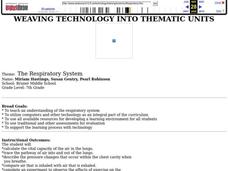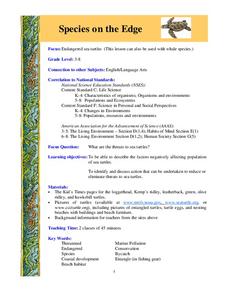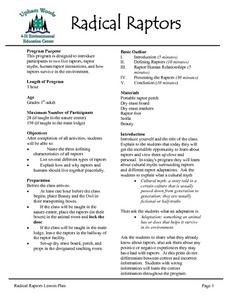Curated OER
The Respiratory System
The student will calculate the vital capacity of the air in the lungs and trace the pathway of air into and out of the lungs. They describe the pressure changes that occur within the chest cavity when you breathe. They compare air that...
Curated OER
Pond Water
Young scholars explore a creek environment. They make observations, identify the living and nonliving factors in the environment and collect a plankton sample to take back to the classroom. In addition, they look at plankton under a...
Curated OER
Species on the Edge
Learners study science. In this endangered species lesson plan, students examine sea turtles and actions that can be taken to help keep them alive. They work in small groups to research different species of turtles and share their...
Curated OER
Environmental Jobs
Students evaluate whether particular jobs have a positive or negative impact on the environment. In this career exploration lesson, students complete a worksheet in pairs to determine if and why various jobs impact the environment.
Curated OER
Plants
Third graders study the factors necessary for plant growth and how plants adapt to their environment. They examine ow different plants require different environments to thrive.
Curated OER
Ozone Pollution- Smog Alert
Students explore ozone pollution. In this ozone pollution instructional activity, students participate in an experiment to simulate smog by using matches, foil, and a covered jar. Students observe how smog effects the environment.
Curated OER
Learning From Leaves: From Observation to Inference
Students examine the adaptation of plants to their environments. They analyze and observe the structure, shape, and internal structure of various leaves, and make inferences about the structures.
Curated OER
Carbon Dioxide Heats It Up
Students design an investigation to test whether vegetation in an area helps regulate the ambient air temperature. They make comparisons between the investigation and global changes in climate. In groups, they present their findings to...
Curated OER
Sun Seeking Plants
Students investigate the story "The Tiny Seed" by Eric Carle. This story is used to introduce the children to the concept that seeds change and grow into plants when conditions in the environment including temperature, light, water and...
Curated OER
The Greenhouse Effect in a Jar
Learners explore climate change by participating in a physical science experiment. In this greenhouse effect lesson plan, students discuss the impact global warming has on our environment and how it works. Learners utilize a glass jar,...
Curated OER
Earth Day
Students participate in activities to make them aware of Earth Day and its significance, and how they can make a difference in saving the environment.
Curated OER
Conservation and Environmental Protection
Students brainstorm a list of environments and animals from around the world that need protection. They then design and create a slogan about an animal or environment and an environmental protection poster.
Curated OER
Beaver Ecology
Students explore the lives of bgeahvers. They identify the physical and behavioral adaptations that help beavers survive in their environment. Students compare and contrast how beavers influence the ecology of both forest and aquatic...
Curated OER
Mining and Land Reclamation - A Classroom Simulation
Students simulate mining mineral resources using cookies. In this earth science lesson, students analyze the cost and profits in mining. They write a lab report about the activity.
Curated OER
Out and About: Sound
Students visit science museums. In this hands-on science lesson, students visit the Magna Science Adventure Center, Thinktank, and the Museum of Science and Industry.
Curated OER
Australia, Oceania, and Antarctica Today
Students explore the importance of research in Antarctica, then explain how snow becomes part of the Antarctic ice cap. They explore Antarctica's harsh environment and discover how scientists drill ice cores and what information ice...
Curated OER
A Hands-On Paper Activity Examining The Relationship Between Hierarchical Levels Of Structure And Function
Students investigate how complex functions arise in biological systems through the creation of several paper structures to accomplish various tasks such as remaining suspended in air for the longest time, making the loudest noise and...
Curated OER
Animals
First graders study the basic needs of animals and compare them to human needs. They make bird feeders using milk carton and pine cones. They review the basic needs of food, water, air, and shelter and discuss what happens when animals...
Curated OER
Forest Friends Forever
Pupils investigate how to use the senses to gather information about objects such as size, shape, color, texture, sound, position, and change (qualitative observations are utilized throughout this lesson plan). They investigate and...
Curated OER
Radical Raptors
Students are introduced to raptors and their role in the environment. They identify three characteristics of raptors and list several types of raptors found in nature. They discuss their positive and negative experiences with raptors and...
Curated OER
Our Space Station Earth
Students discover ways to preserve the Earth's resources. In this natural resources lesson, students investigate how many gallons of water the average American uses per day and then total their estimated usage. Students discuss the...
Curated OER
Don't Use it All Up
Students observe the way that a sponge absorbs liquids and discuss how we our use of natural resources affects the environment around us. They discuss the need to conserve resources so we don't run out of what we need.
Curated OER
Where Do Your Veggies Grow?
First graders investigate the origins of vegetables. In this Science lesson, 1st graders identify where fruits and vegetables come from. Students describe how people utilize plants.
Curated OER
Hypothesize This!
Students role play scientists to prove a hypotheses. They determine whether or not walruses stay warmer in water or in air. Students also determine in which environment they lose more body heat.























